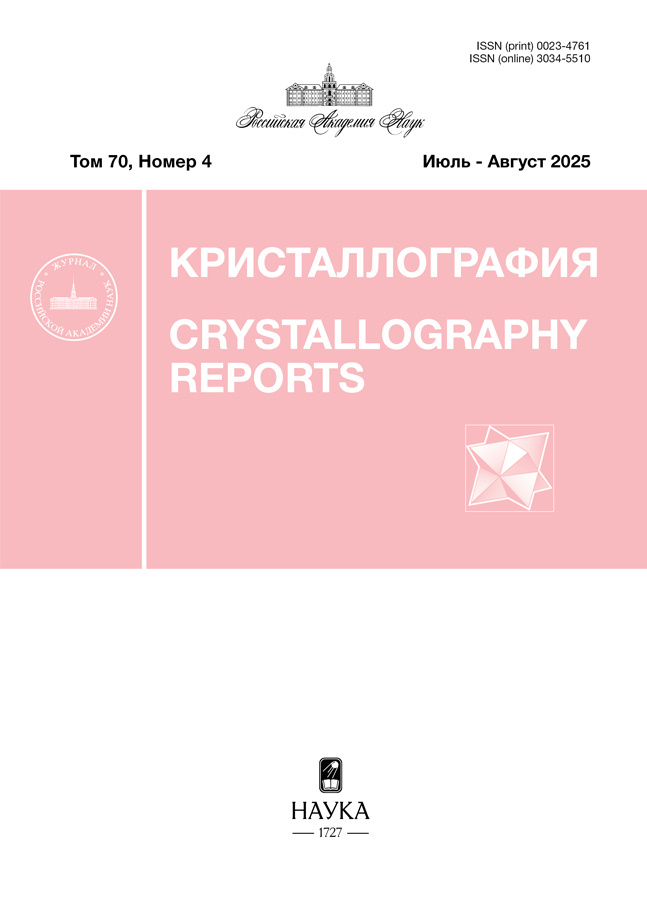Temperature dependence of elastic moduli and period of magnetic spirals in cubic helimagnets with spins in non-equivalent positions
- Авторлар: Chizhikov V.A.1,2, Dmitrienko V.E.2
-
Мекемелер:
- National Research Center “Kurchatov Institute”
- MIREA — Russian Technological University
- Шығарылым: Том 70, № 4 (2025)
- Беттер: 637–642
- Бөлім: ФИЗИЧЕСКИЕ СВОЙСТВА КРИСТАЛЛОВ
- URL: https://cardiosomatics.orscience.ru/0023-4761/article/view/688087
- DOI: https://doi.org/10.31857/S0023476125040123
- EDN: https://elibrary.ru/JGLDGY
- ID: 688087
Дәйексөз келтіру
Аннотация
Critical phenomena in cubic helimagnets with nonequivalent magnetic atoms are investigated within the framework of the Weiss mean-field theory. The reason for the appearance of temperature dependences of elastic moduli and the pitch of the magnetic helicoid is found and the form of these dependences, determining the change in the conditions for the appearance of magnetic skyrmions in type II multiferroic Cu2OSeO3, is predicted.
Толық мәтін
Авторлар туралы
V. Chizhikov
National Research Center “Kurchatov Institute”; MIREA — Russian Technological University
Хат алмасуға жауапты Автор.
Email: chizhikov@crys.ras.ru
Отделение “Институт кристаллографии им. А.В. Шубникова” Курчатовского комплекса кристаллографии и фотоники
Ресей, Moscow; MoscowV. Dmitrienko
MIREA — Russian Technological University
Email: chizhikov@crys.ras.ru
Ресей, Moscow
Әдебиет тізімі
- Bogdanov A., Hubert A. // Phys. Status Solidi. B. 1994. V. 186. P. 527. https://doi.org/10.1002/pssb.2221860223
- Bogdanov A., Hubert A. // J. Magn. Magn. Mater. 1994. V. 138. P. 255. https://doi.org/10.1016/0304-8853(94)90046-9
- Rößler K., Bogdanov A.V., Pfleiderer C. // Nature. 2006. V. 442. P. 797. https://doi.org/10.1038/nature05056
- Grigoriev V., Maleyev S.V., Okorokov A.I. et al. // Phys. Rev. B. 2006. V. 74. P. 214414. https://doi.org/10.1103/PhysRevB.74.214414
- Münzer W., Neubauer A., Adams T. et al. // Phys. Rev. B. 2010. V. 81. P. 041203. https://doi.org/10.1103/PhysRevB.81.041203
- Adams T., Mühlbauer S., Pfleiderer C. et al. // Phys. Rev. Lett. 2011. V. 107. P. 217206. https://doi.org/10.1103/PhysRevLett.107.217206
- Стишов С.М., Петрова А.Е. // Успехи физ. наук. 2011. Т. 181. С. 1157. https://doi.org/10.3367/UFNr.0181.201111b.1157
- Seki S., Yu X.Z., Ishiwata S., Tokura Y. // Science. 2012. V. 336. P. 198. https://doi.org/10.1126/science.1214143
- Adams T., Chacon A., Wagner M. et al. // Phys. Rev. Lett. 2012. V. 108. P. 237204. https://doi.org/10.1103/PhysRevLett.108.237204
- Seki S., Kim J.-H., Inosov D.S. et al. // Phys. Rev. B. 2012. V. 85. P. 220406(R). https://doi.org/10.1103/PhysRevB.85.220406
- Onose Y., Okamura Y., Seki S. et al. // Phys. Rev. Lett. 2012. V. 109. P. 037603. https://doi.org/10.1103/PhysRevLett.109.037603
- Беляков В.А., Дмитриенко В.Е. // Успехи физ. наук. 1985. Т. 146. С. 369. https://doi.org/10.3367/UFNr.0146.198507a.0369
- Wright D.C., Mermin N.D. // Rev. Mod. Phys. 1989. V. 61. P. 385. https://doi.org/10.1103/RevModPhys.61.385
- Tewari S., Belitz D., Kirkpatrick T.R. // Phys. Rev. Lett. 2006. V. 96. P. 047207. https://doi.org/10.1103/PhysRevLett.96.047207
- Binz B., Vishwanath A., Aji V. // Phys. Rev. Lett. 2006. V. 96. P. 207202. https://doi.org/10.1103/PhysRevLett.96.207202
- Hamann A., Lamago D., Wolf T. et al. // Phys. Rev. Lett. 2011. V. 107. P. 037207. https://doi.org/10.1103/PhysRevLett.107.037207
- Дзялошинский И.Е. // ЖЭТФ. 1957. Т. 32. С. 1547.
- Dzyaloshinsky I. // J. Phys. Chem. Solids. 1958. V. 4. P. 241. https://doi.org/10.1016/0022-3697(58)90076-3
- Moriya T. // Phys. Rev. Lett. 1960. V. 4. P. 228. https://doi.org/10.1103/PhysRevLett.4.228
- Moriya T. // Phys. Rev. 1960. V. 120. P. 91. https://doi.org/10.1103/PhysRev.120.91
- Bak P., Jensen M.H. // J. Phys. C. 1980. V. 13. P. L881. https://doi.org/10.1088/0022-3719/13/31/002
- Nakanishi O., Yanase A., Hasegawa A., Kataoka M. // Solid State Commun. 1980. V. 35. P. 995. https://doi.org/10.1016/0038-1098(80)91004-2
- Chizhikov V.A., Dmitrienko V.E. // J. Magn. Magn. Mater. 2015. V. 382. P. 142. https://doi.org/10.1016/j.jmmm.2015.01.032
- Чижиков В.А. // ЖЭТФ. 2021. Т. 159. С. 656. https://doi.org/10.31857/S0044451021040076
- Chizhikov V.A., Dmitrienko V.E. // J. Phys.: Condens. Matter. 2024. V. 36. P. 165603. https://doi.org/10.1088/1361-648X/ad1bf8
- Keffer F. // Phys. Rev. 1962. V. 126. P. 896. https://doi.org/10.1103/PhysRev.126.896
- Yang J.H., Li Z.L., Lu X.Z. et al. // Phys. Rev. Lett. 2012. V. 109. P. 107203. https://doi.org/10.1103/PhysRevLett.109.107203
- Janson O., Rousochatzakis I., Tsirlin A.A. et al. // Nat. Commun. 2014. V. 5. P. 5376. https://doi.org/10.1038/ncomms6376
- Chizhikov V.A., Dmitrienko V.E. // J. Phys.: Condens. Matter. 2017. V. 29. P. 155601. https://doi.org/10.1088/1361-648X/aa61e7
Қосымша файлдар













